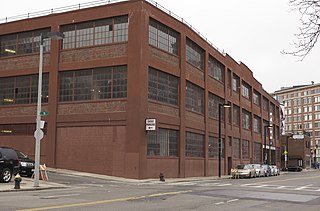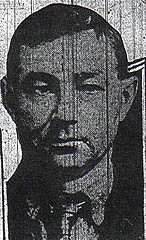Related Research Articles

Bank robbery is the criminal act of stealing from a bank, specifically while bank employees and customers are subjected to force, violence, or a threat of violence. This refers to robbery of a bank branch or teller, as opposed to other bank-owned property, such as a train, armored car, or (historically) stagecoach. It is a federal crime in the United States.

The Great Brink's Robbery was an armed robbery of the Brink's building in the North End of Boston, Massachusetts, on January 17, 1950. The $2.775 million theft consisted of $1,218,211.29 in cash and $1,557,183.83 in checks, money orders, and other securities. It was at the time the largest robbery in the history of the United States and has been called "the crime of the century". The robbery remained unsolved for nearly six years, until estranged group member Joseph O'Keefe testified only days before the statute of limitations would have expired.

Harry "Pete" Pierpont was a Prohibition era gangster, convicted murderer and bank robber. He was a friend and mentor to John Dillinger.
The Fleagle Gang was a group of early 20th century American bank robbers and murderers. They were found and executed or killed after robbing the First National Bank in Lamar, Colorado. Their cases were the first in which the Federal Bureau of Investigation (FBI) used a single fingerprint as part of the evidence leading to a conviction. They were also suspected to have committed a series of previous bank robberies over a 10-year period.

Charles Omer Makley, also known as Charles McGray and Fat Charles, was an American criminal and bank robber active in the early 20th century, most notably as a criminal associate of John Dillinger.

Homer Virgil Van Meter was an American criminal and bank robber active in the early 20th century, most notably as a criminal associate of John Dillinger and Baby Face Nelson.

The Dillinger Gang was a group of American Depression-era bank robbers led by John Dillinger. The gang gained notoriety for a successful string of bank robberies, using modern tools and tactics, in the Midwestern United States from September 1933 to July 1934. During this crime spree, the gang killed 10 and wounded 7. They managed to pull off three jail breaks which wounded two guards and killed a sheriff.
The Reno Gang, also known as the Reno Brothers Gang and The Jackson Thieves, were a group of criminals that operated in the Midwestern United States during and just after the American Civil War. Though short-lived, the gang carried out the first three peacetime train robberies in U.S. history. Most of the stolen money was never recovered.

Marion Columbus Hedgepeth – also known as the Handsome Bandit, the Debonair Bandit, the Derby Kid and the Montana Bandit – was a famous Wild West outlaw.

Herman Karl Lamm, known as Baron Lamm, was a German-American bank robber. A former Prussian Army soldier who immigrated to the United States, Lamm believed a heist required all the planning of a military operation. He pioneered the concepts of "casing" a bank and developing escape routes before conducting the robbery. Using a meticulous planning system called "The Lamm Technique", he conducted dozens of successful bank robberies from the end of World War I.
Fred Pierpont was the younger brother of Prohibition era gangster Harry Pierpont. He was often suspected and arrested for being a front man for his brother's bank robberies.
Mary Northern Kinder was a Prohibition era gun moll, most noted for being the girlfriend of Harry Pierpont and associate of John Dillinger. Along with Pearl Elliott, she was one of two women listed by the Chicago Police Department's Public Enemies list in 1933.
George Earl "The Kid" Northern (1903–1936) was a Prohibition-era bank robber and early associate of Harry Pierpont. He was the older brother of Pierpont's girlfriend, Mary Kinder.
Thaddeus R. 'Ted' Skeer was an American Prohibition-era bank robber, best known as an early associate of Harry Pierpont.
Pearl Elliott was a notorious madam of Kokomo, Indiana, United States. She was best known as an early associate of the Prohibition era gangster Harry Pierpont and later of the bank robber John Dillinger. Along with the gun moll Mary Kinder, she was one of two women listed on the Chicago Police Department's Public Enemies list in 1933.
Lena Pierpont was the mother of Prohibition gangster Harry Pierpont. Her fierce loyalty to her son and his compatriots led to her arrest on numerous occasions by police in an attempt to ascertain her son's whereabouts.
Sylvia Clevenger was an American prostitute who worked with madam Pearl Elliott and was a minor associate of the John Dillinger gang. Her brother William was the former husband of Elliott. She was married three times, reverting to her maiden name of Hughes after her divorce from her second husband, John Clevenger, in 1930. She lived for much of her life in Kokomo, Indiana, and died in 1951 in Michigan City, Indiana.

Major Grom is a 2017 Russian short action film directed by Vladimir Besedin, based on the comic character Major Grom.
The Lincoln National Bank robbery took place on September 17, 1930 when a group of armed men entered a bank in Lincoln, Nebraska, stole approximately $2.7 million in cash and securities, and then fled with help of a getaway driver. No one was seriously injured during the robbery. The majority of the money was never recovered.
References
- ↑ "1940 United States Federal Census". Ancestry. Retrieved 18 December 2023.
- 1 2 3 4 5 6 7 Police Keep On Trail Of The Bandits article, Marion Leader-Tribune, Marion, Indiana, November 27, 1924, p. 1.
- 1 2 3 4 No New Clue Of Value On The Robbery article, Marion Leader-Tribune, Marion, Indiana, November 28, 1924, p. 1
- 1 2 3 Attempt Made To Rob Noblesville Bank Frustrated article, Marion Leader-Tribune, Marion, Indiana, December 17, 1924, p. 1
- ↑ Bandits Fail In Attempt To Rob Noblesville Bank article, Indianapolis Star, Indianapolis, Indiana, December 17, 1924, p. 1
- 1 2 3 4 Auto Used By Bank Bandits Is Found article, Marion Leader-Tribune, Marion, Indiana, December 28, 1924, p. 1
- 1 2 3 4 5 6 7 Upland State Bank Robbed of $2500 article, Marion Leader-Tribune, Marion, Indiana, December 24, 1924, p. 1
- ↑ Identify Three Men As Kokomo Bank Bandits article, Kokomo Daily Tribune, Kokomo, Indiana, April 3, 1925, p.1
- 1 2 Rob Galveston Bank $3000 article, Logansport Pharos-Tribune, Logansport, Indiana, June 6, 1925, p. 1
- ↑ "Bank Robber Implicates Leader of the Marion Gang", Marion (IN) Leader-Tribune, May 5, 1925, p.1
- ↑ Jury Balks At Locking Bandit Away For Life article, Kokomo Daily Tribune, Kokomo, Indiana, June 26, 1925, p. 1.
- 1 2 3 4 5 Last Marion Bank Bandit Captured article, Marion Leader-Tribune, Marion, Indiana, June 20, 1925, p. 1.
- ↑ "Desperado Given Prison Sentence— Everett Bridgewater on Way to State Reformatory Less Than 24 Hours After His Arrest", The South Bend Tribune, June 21, 1925, p.1
- ↑ "Pave Way for Parole", The Indianapolis Times, April 10, 1934, p.4
- ↑ Hoosier Highlights article, Kokomo Daily Tribune, Kokomo, Indiana, June 30, 1925, p. 6.
- ↑ Local Police Interested In Man's Arrest article, Kokomo Daily Tribune, Kokomo, Indiana, July 3, 1925, p. 3.
- 1 2 Grab Clifford Roth article, Kokomo Daily Tribune, Kokomo, Indiana, July 4, 1925, p. 1.
- 1 2 3 4 5 6 Kokomo Bank Robber Facing 21 Year Term article, Kokomo Tribune, Kokomo, Indiana, April 30, 1936, p. 1.